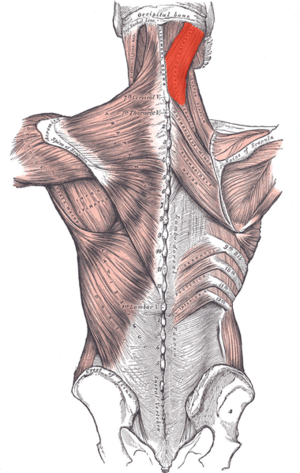Splenius Capitis
Original Editor - Venus Pagare
Top Contributors - Rachel Vogel, Lucinda hampton, Oyemi Sillo, Venus Pagare, WikiSysop, Kim Jackson, Ahmed Nasr and Tarina van der Stockt
Description[edit | edit source]
Splenius capitis is a thick, flat muscle at the posterior aspect of the neck arising from the midline and extending superolaterally to the cervical vertebrae and, along with the splenius cervicis, comprise the superficial layer of intrinsic back muscles.[1]
In relation to its surrounding musculature, it sits:
- Deep to the trapezius
- Superficial to the semispinalis capitis and the longissimus capitis
- Forms the floor of the posterior neck triangle, positioned between the sternocleidomastoid and the trapezius
Origin[edit | edit source]
Lower half of ligamentum nuchae (C4-C6) and spinous process of C7-T3[1]
Insertion[edit | edit source]
Superior nuchal line, mastoid process of temporal bone, and rough surface adjoining occipital bone[1]
Nerve Supply[edit | edit source]
Lateral branches of the posterior rami of the middle and lower cervical spinal nerves.[1]
Blood Supply[edit | edit source]
Muscular branches of the occipital artery from the external carotid artery.[1]
Action[edit | edit source]
Splenius capitis assists in supporting the head in the erect position.[1]
Acting bilaterally: extension of the head and cervical spine
Acting unilaterally: lateral flexion of the head and neck and rotation the head to the same side (when working synergistically with sternocleidomastoid). [1]
Synergists: splenius cervicis, semispinalis capitis, semispinalis cervicis, superior portion of trapezius.
Treatment[edit | edit source]
Dysfunction of splenius capitis may be found in those with mechanical chronic neck pain[2] or whiplash disorders.
The American Physical Therapy Association (APTA) revised the clinical practice guidelines in 2017. Briefly; for patients with chronic neck pain (with radiating pain), mechanical intermittent cervical traction, combined with stretches and strengthening exercises and cervical/thoracic mobilisation/manipulation have shown to have a positive effect.[3]
In people with neck pain there may also be overactivity of superficial muscles, splenius capitis and inhibition of Semispinalis Cervicis.[4] Effective management of this condition should include exercises that focus on activating Semispinalis Cervicis, as well as stretching and myofascial release of the splenius capitis.
References[edit | edit source]
- ↑ 1.0 1.1 1.2 1.3 1.4 1.5 1.6 Moore KL. Dalley AF. Agur AMR. Clinically Orientated Anatomy. 7th edition. Philadelphia: Lippincott Williams & Wilkins, 2014.
- ↑ Bonilla-Barba L. Lima Florencio L. Rodriguez-Jimenez J. Falla D. Fernandez-de-las-Penas C. Ortega-Santiago R. Women with mechanical neck pain exhibit increased activation of their superficial neck extensors when performing the cranio-cervical flexion test. Musculoskeletal Science and Practice. 2020;49:102222.
- ↑ Blanpied PR. Gross AR. Elliott JM. Devaney LL. Clewley D. Walton DM. Sparks C. Robertson EK. Altman RD. Beattie P. Boeglin E. Neck pain: revision 2017: clinical practice guidelines linked to the international classification of functioning, disability and health from the orthopaedic section of the American Physical Therapy Association. Journal of Orthopaedic & Sports Physical Therapy. 2017;47(7):A1-83.
- ↑ Schomacher J. Erlenwein J. Dieterich A. Petzke F. Petzkeb F. Falla D. Can neck exercises enhance the activation of the semispinalis cervicis relative to the splenius capitis at specific spinal levels? Manual therapy. 2015;20:694-702.
- ↑ Painotopia. Splenius capitis and cervicis pain & trigger points – myofascial release. Avaliable from https://www.youtube.com/watch?v=ZFSn6QEMyPM (accessed 14/11/2021)
- ↑ MSK Neurology. Exercise for the splenius capitis muscle. Avaliable from https://www.youtube.com/watch?v=dEpNRI-DfKw (assessed 14/11/2021)







